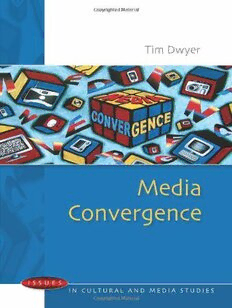
Media Convergence (Issues in Cultural and Media Studies) PDF
217 Pages·2010·4.118 MB·English
Most books are stored in the elastic cloud where traffic is expensive. For this reason, we have a limit on daily download.
Preview Media Convergence (Issues in Cultural and Media Studies)
Description:
With Media Convergence, Tim Dwyer has given us a bold restatement of the political economy approach for a 21st century media environment where traditional industry silos are collapsing, and where media users are increasingly engaged with the production and distribution of media and not simply its consumption. The book displays considerable attention to institutional detail and comparative analysis, and is well designed to provide a road map of current and future trends for policy makers and media activists, as well as students and future workers in the convergent media space. Professor Terry Flew, Creative Industries Faculty, Queensland University of Technology, Australia How will people access digital media content in the future? What combination of TV, computer or mobile device will be employed? Which kinds of content will become commonplace? Rapid changes in technology and the media industries have led to new modes of distributing and consuming information and entertainment across platforms and devices. It is now possible for newspapers to deliver breaking news by email alerts or RSS feeds, and for audiovisual content to be read, listened to or watched at a convenient time, often while on the move. This process of 'media convergence', in which new technologies are accommodated by existing media industries, has broader implications for ownership, media practices and regulation. Dwyer critically analyses the political, economic, cultural, social, and technological factors that are shaping these changing media practices. There are examples of media convergence in everyday life throughout, including IPTV, VoIP and Broadband networks. The impacts of major traditional media players moving into the online space is illustrated using case studies such as the acquisition of the social networking site MySpace by News Corporation, and copyright issues on Google's YouTube. This informative resource is key reading for media studies students, researchers, and anyone with an interest in media industries, policy and regulation.
See more
The list of books you might like
Most books are stored in the elastic cloud where traffic is expensive. For this reason, we have a limit on daily download.
